- Vue——Vue-cli脚手架+前端路由
pdsu_zhao
VueVue学习之旅vuev-routerv-resourcevue-cliES6
Vue-cli是Vue的脚手架工具可以进行目录结构、本地调试、代码部署、热加载、单元测试1、MVVM框架View——ViewModel——Model(视图)(通讯)(数据)“DOM”“观察者vue实例”“Javascript”注意:交互为双向的特点:(1)针对具有复杂交互逻辑的前端应用;(2)提供基础的架构抽象;(3)通过Ajax数据持久化,保证前端用户体验。2、什么是Vue.js它是一个轻量级M
- AsyncHttpClient使用说明书
有梦想的攻城狮
netty学习专栏Javaasynchttpclient异步处理netty
[[toc]]AsyncHttpClient(AHC)是一个高性能、异步的HTTP客户端库,广泛用于Java和Scala应用中,特别适合处理高并发、非阻塞的HTTP请求。它基于Netty或Java原生的异步HTTP客户端实现,支持HTTP/1.1和HTTP/2协议,适用于微服务、API调用、爬虫等场景。1.核心特性特性说明异步非阻塞基于事件驱动模型,避免线程阻塞,支持高并发(如每秒数千请求)。HT
- Java的包结构
MingDong523
笔记
Java的包结构类就相当于文件夹(目录)。包结构的作用一般有以下两个方面第一个就是Java的包是根据Java文件的功能和性质来区分,方便区分和查找另一个就是重复的文件名可以存在于不同的包(文件夹)里。当我们选择去创建Java包时有两种创建方式,其中一种就是手动创建,手动创建包太过繁琐,不推荐。而另一种就是使用代码去创建(打包语句package),当我们使用打包语句时要注意一下几点1.在写packa
- Java中String类型的20个方法
MingDong523
笔记
根据长度来使用的方法:返回类型:int方法签名:String.length()作用:用来计算String中字符的个数根据数组来使用的方法:返回类型:byte类型的数组byte[]方法签名:String.getBytes()作用:将String类型转换成byte类型的数组返回类型:char类型的数组char[]方法签名:String.toCharArray()作用:将String类型转变成char类
- 深入浅出:序列化与反序列化的全面解析
进击的小白菜
一些开发常识开发语言开发常识
文章目录1.引言2.什么是序列化?2.1为什么需要序列化?3.什么是反序列化?3.1反序列化的重要性4.序列化与反序列化的实现4.1JSON(JavaScriptObjectNotation)4.2XML(eXtensibleMarkupLanguage)4.3ProtocolBuffers(Protobuf)4.4MessagePack5.安全性考虑6.性能优化7.结论附录:常见问题解答Q1:什
- Java高频面试之集合-13
牛马baby
面试职场和发展java哈希算法HashMap
hello啊,各位观众姥爷们!!!本baby今天来报道了!哈哈哈哈哈嗝面试官:为什么hash函数能降哈希碰撞?哈希函数通过以下核心机制有效降低碰撞概率,确保不同输入尽可能映射到不同的哈希值:一、设计原理与数学基础均匀分布(UniformDistribution)目标:使任意输入经过哈希计算后,结果在输出空间中均匀分布。数学方法:利用模运算、位操作等,确保输入变化时哈希值的变化无规律。示例:#简单哈
- Java高频面试之集合-08
牛马baby
java面试python
hello啊,各位观众姥爷们!!!本baby今天来报道了!哈哈哈哈哈嗝面试官:详细说说CopyOnWriteArrayListCopyOnWriteArrayList详解CopyOnWriteArrayList是Java并发包(java.util.concurrent)中提供的线程安全列表,基于“写时复制”(Copy-On-Write)机制实现。它适用于读多写少的高并发场景,如事件监听器列表、配置
- Java高频面试之集合-02
牛马baby
java面试开发语言
hello啊,各位观众姥爷们!!!本baby今天来报道了!哈哈哈哈哈嗝面试官:说说队列queueJava队列(Queue)详解队列(Queue)是Java集合框架中一种先进先出(FIFO)的线性数据结构,广泛应用于生产者-消费者模型、任务调度、线程池等场景。Java提供了丰富的队列实现,涵盖线程安全、阻塞、优先级等特性。一、队列的核心接口与操作Java队列的顶层接口是java.util.Queue
- Java高频面试之集合-07
牛马baby
java面试开发语言
hello啊,各位观众姥爷们!!!本baby今天来报道了!哈哈哈哈哈嗝面试官:ArrayList和Vector的区别是什么?ArrayList与Vector的区别详解ArrayList和Vector都是Java中基于动态数组实现的List接口的实现类,但它们在设计、性能和线程安全性上有显著差异。以下是两者的核心区别:1.线程安全性特性ArrayListVector线程安全非线程安全(方法未同步)线
- Java高频面试之SE-23
牛马baby
java面试windows
hello啊,各位观众姥爷们!!!本baby今天又来了!哈哈哈哈哈嗝Java中的Stream是Java8引入的一种全新的数据处理方式,它基于函数式编程思想,提供了一种高效、简洁且灵活的方式来操作集合数据。Stream的核心思想是声明式编程(告诉程序“做什么”,而不是“怎么做”)。1.Stream的核心特点无存储:Stream不存储数据,只是对数据源的视图(如集合、数组、I/O通道等)。函数式操作:
- 2025计算机毕设全流程实战指南:Java/Python+协同过滤+小程序开发避坑手册
启点毕设
课程设计javapython大四论文指南查重降重技巧毕业设计spring
技术框架的选择是项目开发的关键起点,直接影响开发效率和最终成果质量。然而,许多开发者在选择技术框架时面临困难:现有知识储备不足以支撑复杂项目需求,团队经验有限,框架选择缺乏前瞻性常导致后期问题。尽管技术框架的选择过程充满挑战,但合适的框架能为项目开发和维护奠定基础,而不当的选择则可能带来持续的技术债务和开发困扰。所以,建议对项目技术框架把握不好的同学,最好是找自己的研究生学长或者老师详细的把关机技
- linux服务器上的项目读取本地文件,java访问linux服务器读取文件路径
防晒霜白癜风患者
java访问linux服务器读取文件路径内容精选换一换通过ADC将文件传输到Host。参见准备环境完成环境配置。以运行用户登录安装Toolkit组件的服务器。执行命令,将A.java文件传输到Host的指定路径下。adc--hostxx.xx.xx.xx:22118--sync/tmp/A.java"~/ide_daemon"将xx.xx.xx.xx替换为实际的Host的IP地址。如果Conv2D
- [0948]基于JAVA的城市路网智慧管理系统的设计与实现
阿鑫学长【毕设工场】
javapython人工智能毕业设计课程设计
毕业设计(论文)开题报告表姓名学院专业班级题目基于JAVA的城市路网智慧管理系统的设计与实现指导老师(一)选题的背景和意义开题报告背景与意义:随着我国城市化进程的加快,城市路网系统日益庞大复杂,交通管理面临的挑战愈发严峻。传统的路网管理模式由于信息更新不及时、数据处理效率低下、智能化程度不足等问题,已无法满足现代城市管理对高效、精准、智能交通管理的需求。因此,设计并实现一套基于Java的城市路网智
- 45-JavaEE 开发中的动态代理与序列化技术
只不过是胆小鬼罢了
WEB安全开发java
在JavaEE开发领域,动态代理与序列化技术是两个关键知识点,它们在很多场景下发挥着重要作用。以下是对这两部分知识的深入探讨。动态代理代理模式概述代理模式是Java中常用的设计模式之一,其核心思想是代理类与委托类实现相同的接口。代理类的主要职责是为委托类进行预处理、消息过滤、转发消息以及事后处理等操作。这种模式在很多场景下都有应用,比如权限控制、日志记录、事务管理等。JDK动态代理实现步骤创建接口
- Electron打包文件生成.exe文件打开即可使用
糕冷小美n
electronjavascript前端
1、Electron打包,包括需要下载的内容和环境配置步骤注意:Electron是一个使用JavaScript、HTML和CSS构建跨平台桌面应用程序的框架首先需要电脑环境有Node.js和npm我之前的文章有关nvm下载node的说明也可以去官网下载检查是否有node和npm环境命令node-vnpm-v输出版本号,说明安装成功2、创建Electron项目2.1创建项目目录打开命令行工具,创建一
- JavaScript基础-事件对象
難釋懷
javascript开发语言
在现代Web开发中,事件处理是实现动态和交互式网页的核心。当用户与页面进行交互时(如点击按钮、提交表单等),浏览器会生成相应的事件。为了有效地响应这些事件,JavaScript提供了事件对象,它包含了关于事件的详细信息。本文将详细介绍事件对象的概念、重要的属性和方法,并通过实例展示其应用场景。一、什么是事件对象?每当一个事件被触发时,浏览器都会创建一个事件对象,这个对象包含了该事件的所有相关信息,
- Java 常用类Date
浅橙boy
java开发语言
这次介绍Java中常用类中的一种Date,一般常用的Date的包名为util即java.util.Date。还有一种Date类的包名为spl即java.spl.Date,这次不做介绍。包名为spl的Date类作用于和spl数据库打交道,其内容只包括日期,没有时间,包名为util的Date类作用于平常日期使用其内容包括日期和时间,且大部分的构造器和方法已经过时了,下面介绍的是平时还可以使用的方法和构
- 学习-Java常用类之Calendar类
AIains
Educoder—Javajava
第1关:学习-Java常用类之Calendar类任务描述相关知识编程要求测试说明任务描述本关任务:获取给定年月的最后一天。相关知识我们通过之前的学习已经能够格式化并创建一个日期对象了,但是我们如何才能设置和获取日期数据的特定部分呢,比如说小时,日,或者分钟?我们又如何在日期的这些部分加上或者减去值呢?calendar类是一个抽象类,是Java日期处理的核心类之一。Calendar类为操作日历字段,
- Java基础回顾 Day5
小斌的Debug日记
Java基础回顾java开发语言
基础数据类型4类8种byte8位(常用流操作)short16位(运用场景不多)int32位(最常用)long64位(常用于表示时间毫秒)float32位(精度为7位,精度低)double64位(精度为15位,更常用)char16位(也可以算术运算)boolean8位(值为true或者false)基本数据类型的转换小转大为隐式转换,大转小为显式转换可能会丢失精度i++和++ii++是先取值在加1,而
- Three.js世界中的三要素:场景、相机、渲染器
Front_Yue
3D技术实践指南javascriptthree.js3d
一、Three.js简介Three.js是一个基于WebGL的JavaScript库,它允许开发者在网页上创建和显示复杂的3D图形和动画,而无需用户安装任何额外的插件或软件。Three.js在Web开发中的地位非常重要,它通过提供简单直观的API,极大地降低了3D图形开发的门槛,使得开发者可以更专注于实现创意。Three.js广泛应用于游戏开发、虚拟现实、数据可视化、艺术创作等多个领域。二、场景:
- 【Kivy App】Pyjnius是什么?
Botiway
移动APPKivypython
Pyjnius是一个Python库,用于在Python中访问Java类和方法,特别适用于在Kivy或其它Python应用中调用AndroidAPI。以下是Pyjnius的详细介绍、安装和使用方法:1.Pyjnius是什么?Pyjnius是一个Python-to-Java的桥接工具,允许Python代码直接调用Java类和方法。它基于JavaNativeInterface(JNI),主要用于以下场景
- 代码训练day7哈希表2
徵686
散列表数据结构
1.四数相加IIleetcode454哈希表判断是否存在classSolution{//四数相加ii统计个数publicintfourSumCount(int[]nums1,int[]nums2,int[]nums3,int[]nums4){HashMapmap=newHashMapmagazine.length())returnfalse;//java字符串长度s.length()for(cha
- 若依集成knife4j实现swagger文档增强
Roc-xb
knife4j
knife4j的前身是swagger-bootstrap-ui,为了契合微服务的架构发展,由于原来swagger-bootstrap-ui采用的是后端Java代码+前端Ui混合打包的方式,在微服务架构下显的很臃肿,因此项目正式更名为knife4j。目录一、单体版本1、ruoyi-admin\pom.xml模块添加整合依赖2、SwaggerController.java修改跳转访问地址二、前后端分离
- 猫头虎 分享已解决Bug || java.lang.ClassNotFoundException 全解析与解决方案
AI后端
已解决的Bug专栏bugjava开发语言服务发现rustpythonpip
猫头虎分享已解决Bug||java.lang.ClassNotFoundException全解析与解决方案摘要:最近有粉丝在后台留言,问到项目启动时遇到了一个经典问题:java.lang.ClassNotFoundException。这个问题看似简单,却困扰了无数开发者。今天,猫头虎以真实开发经历为背景,从Bug原因剖析到全方位解决方案,手把手带你攻克这个问题!本文涵盖了:问题原因:从类加载机制到
- Android Studio 中将 AAR 包发布到 Maven 本地仓库
帅次
AndroidStudioandroidstudiomavenandroidkotlinfluttergradlemacos
目录1.配置build.gradle.kts(或build.gradle)2.配置publishing任务3.发布到本地Maven仓库3.1Couldnotfindmethodpublications()forarguments...3.2bash:./gradlew:Permissiondenied3.3AndroidGradlepluginrequiresJava17torun.Youarec
- android视频缓存框架 [AndroidVideoCache](https://github.com/danikula/AndroidVideoCache) 源码解析与评估
MrJarvisDong
thirdparty源码
文章目录android视频缓存框架[AndroidVideoCache](https://github.com/danikula/AndroidVideoCache)源码解析与评估引言使用方式关键类解析HttpProxyCacheServer代理缓存服务类**java.net.ProxySelector**代理选择Pinger判断本地serverSocket是否存活GetRequest封装用于获取
- 基于JAVA中的spring框架和jsp实现自然灾害论坛平台项目【附项目源码+论文说明】
大雄是个程序员
项目实践自然灾害论坛平台java项目源码spring毕业设计课程设计网页设计
摘要在上个世纪末期,也就是20世纪末,随着计算机技术的发展与进步和数据库方面的知识在互联网的大力运用,互联网技术以及网站技术在网上的大力推广,网上论坛(自然灾害论坛)也逐渐在网兴起,它的出现帮助了网上各种特定的群体进行一个在线的知识传递与信息的交流。本计算机自然灾害论坛设计,采用了JSP(JAVA)技术和MYSQL数据库开发,尝试实现了自然灾害论坛的基本功能以及帮助我们掌握了论坛技术的核心特点。该
- Java架构师成长之路
hweiyu00
分享spring微服务springcloudjava
概述本教程主要从6个方面,全面讲解Java技术栈的知识。1.性能调优深入理解MySQL底层原理、索引逻辑,数据结构与算法。使用Explain进行优化分析MVCC原理剖析日志机制解析2.框架源码掌握Spring底层原理带你手写一个Spring解析IOC、AOP源码、以及事务原理3.并发编程剖析Java底层锁机制CAS、JUC工具使用、AQS源码分析以及并发的集合类的讲解4.分布式开发剖析分布式中使用
- Java面试高频问题深度解析:JVM、锁机制、SQL优化与并发处理
Debug Your Career
面试java面试jvm
问题列表Java中如何实现一个工作流引擎?Bean的作用域有哪些?JVM中的锁机制是如何工作的?三个方法分别被synchronized锁住,方法a调用方法b,b能获取到a的锁吗?会有什么问题?SQL优化时,EXPLAIN中需要关注哪些关键点?什么是覆盖索引?SELECT*一定不会命中索引吗?SELECT*和SELECT全字段在性能上有区别吗?什么是回表?它与索引有什么关系?100万数据分给10个线
- JavaScript基础-DOM的一些基本常用语法
Southern Wind
JavaScriptjavascript
总结了一下JS一直到DOM中所用的单词的用法输入方式:window.prompt('请输入数据');输出方式:1、window.alert('HelloJavaScript');2、console.log输出到控制台3、输出数据到页面document.write('hello')JavaScript数据类型1、基本类型string:字符型number:数值型boolean:布尔型2、特殊类型und
- Java实现的基于模板的网页结构化信息精准抽取组件:HtmlExtractor
yangshangchuan
信息抽取HtmlExtractor精准抽取信息采集
HtmlExtractor是一个Java实现的基于模板的网页结构化信息精准抽取组件,本身并不包含爬虫功能,但可被爬虫或其他程序调用以便更精准地对网页结构化信息进行抽取。
HtmlExtractor是为大规模分布式环境设计的,采用主从架构,主节点负责维护抽取规则,从节点向主节点请求抽取规则,当抽取规则发生变化,主节点主动通知从节点,从而能实现抽取规则变化之后的实时动态生效。
如
- java编程思想 -- 多态
百合不是茶
java多态详解
一: 向上转型和向下转型
面向对象中的转型只会发生在有继承关系的子类和父类中(接口的实现也包括在这里)。父类:人 子类:男人向上转型: Person p = new Man() ; //向上转型不需要强制类型转化向下转型: Man man =
- [自动数据处理]稳扎稳打,逐步形成自有ADP系统体系
comsci
dp
对于国内的IT行业来讲,虽然我们已经有了"两弹一星",在局部领域形成了自己独有的技术特征,并初步摆脱了国外的控制...但是前面的路还很长....
首先是我们的自动数据处理系统还无法处理很多高级工程...中等规模的拓扑分析系统也没有完成,更加复杂的
- storm 自定义 日志文件
商人shang
stormclusterlogback
Storm中的日志级级别默认为INFO,并且,日志文件是根据worker号来进行区分的,这样,同一个log文件中的信息不一定是一个业务的,这样就会有以下两个需求出现:
1. 想要进行一些调试信息的输出
2. 调试信息或者业务日志信息想要输出到一些固定的文件中
不要怕,不要烦恼,其实Storm已经提供了这样的支持,可以通过自定义logback 下的 cluster.xml 来输
- Extjs3 SpringMVC使用 @RequestBody 标签问题记录
21jhf
springMVC使用 @RequestBody(required = false) UserVO userInfo
传递json对象数据,往往会出现http 415,400,500等错误,总结一下需要使用ajax提交json数据才行,ajax提交使用proxy,参数为jsonData,不能为params;另外,需要设置Content-type属性为json,代码如下:
(由于使用了父类aaa
- 一些排错方法
文强chu
方法
1、java.lang.IllegalStateException: Class invariant violation
at org.apache.log4j.LogManager.getLoggerRepository(LogManager.java:199)at org.apache.log4j.LogManager.getLogger(LogManager.java:228)
at o
- Swing中文件恢复我觉得很难
小桔子
swing
我那个草了!老大怎么回事,怎么做项目评估的?只会说相信你可以做的,试一下,有的是时间!
用java开发一个图文处理工具,类似word,任意位置插入、拖动、删除图片以及文本等。文本框、流程图等,数据保存数据库,其余可保存pdf格式。ok,姐姐千辛万苦,
- php 文件操作
aichenglong
PHP读取文件写入文件
1 写入文件
@$fp=fopen("$DOCUMENT_ROOT/order.txt", "ab");
if(!$fp){
echo "open file error" ;
exit;
}
$outputstring="date:"." \t tire:".$tire."
- MySQL的btree索引和hash索引的区别
AILIKES
数据结构mysql算法
Hash 索引结构的特殊性,其 检索效率非常高,索引的检索可以一次定位,不像B-Tree 索引需要从根节点到枝节点,最后才能访问到页节点这样多次的IO访问,所以 Hash 索引的查询效率要远高于 B-Tree 索引。
可能很多人又有疑问了,既然 Hash 索引的效率要比 B-Tree 高很多,为什么大家不都用 Hash 索引而还要使用 B-Tree 索引呢
- JAVA的抽象--- 接口 --实现
百合不是茶
抽象 接口 实现接口
//抽象 类 ,方法
//定义一个公共抽象的类 ,并在类中定义一个抽象的方法体
抽象的定义使用abstract
abstract class A 定义一个抽象类 例如:
//定义一个基类
public abstract class A{
//抽象类不能用来实例化,只能用来继承
//
- JS变量作用域实例
bijian1013
作用域
<script>
var scope='hello';
function a(){
console.log(scope); //undefined
var scope='world';
console.log(scope); //world
console.log(b);
- TDD实践(二)
bijian1013
javaTDD
实践题目:分解质因数
Step1:
单元测试:
package com.bijian.study.factor.test;
import java.util.Arrays;
import junit.framework.Assert;
import org.junit.Before;
import org.junit.Test;
import com.bijian.
- [MongoDB学习笔记一]MongoDB主从复制
bit1129
mongodb
MongoDB称为分布式数据库,主要原因是1.基于副本集的数据备份, 2.基于切片的数据扩容。副本集解决数据的读写性能问题,切片解决了MongoDB的数据扩容问题。
事实上,MongoDB提供了主从复制和副本复制两种备份方式,在MongoDB的主从复制和副本复制集群环境中,只有一台作为主服务器,另外一台或者多台服务器作为从服务器。 本文介绍MongoDB的主从复制模式,需要指明
- 【HBase五】Java API操作HBase
bit1129
hbase
import java.io.IOException;
import org.apache.hadoop.conf.Configuration;
import org.apache.hadoop.hbase.HBaseConfiguration;
import org.apache.hadoop.hbase.HColumnDescriptor;
import org.apache.ha
- python调用zabbix api接口实时展示数据
ronin47
zabbix api接口来进行展示。经过思考之后,计划获取如下内容: 1、 获得认证密钥 2、 获取zabbix所有的主机组 3、 获取单个组下的所有主机 4、 获取某个主机下的所有监控项
- jsp取得绝对路径
byalias
绝对路径
在JavaWeb开发中,常使用绝对路径的方式来引入JavaScript和CSS文件,这样可以避免因为目录变动导致引入文件找不到的情况,常用的做法如下:
一、使用${pageContext.request.contextPath}
代码” ${pageContext.request.contextPath}”的作用是取出部署的应用程序名,这样不管如何部署,所用路径都是正确的。
- Java定时任务调度:用ExecutorService取代Timer
bylijinnan
java
《Java并发编程实战》一书提到的用ExecutorService取代Java Timer有几个理由,我认为其中最重要的理由是:
如果TimerTask抛出未检查的异常,Timer将会产生无法预料的行为。Timer线程并不捕获异常,所以 TimerTask抛出的未检查的异常会终止timer线程。这种情况下,Timer也不会再重新恢复线程的执行了;它错误的认为整个Timer都被取消了。此时,已经被
- SQL 优化原则
chicony
sql
一、问题的提出
在应用系统开发初期,由于开发数据库数据比较少,对于查询SQL语句,复杂视图的的编写等体会不出SQL语句各种写法的性能优劣,但是如果将应用系统提交实际应用后,随着数据库中数据的增加,系统的响应速度就成为目前系统需要解决的最主要的问题之一。系统优化中一个很重要的方面就是SQL语句的优化。对于海量数据,劣质SQL语句和优质SQL语句之间的速度差别可以达到上百倍,可见对于一个系统
- java 线程弹球小游戏
CrazyMizzz
java游戏
最近java学到线程,于是做了一个线程弹球的小游戏,不过还没完善
这里是提纲
1.线程弹球游戏实现
1.实现界面需要使用哪些API类
JFrame
JPanel
JButton
FlowLayout
Graphics2D
Thread
Color
ActionListener
ActionEvent
MouseListener
Mouse
- hadoop jps出现process information unavailable提示解决办法
daizj
hadoopjps
hadoop jps出现process information unavailable提示解决办法
jps时出现如下信息:
3019 -- process information unavailable3053 -- process information unavailable2985 -- process information unavailable2917 --
- PHP图片水印缩放类实现
dcj3sjt126com
PHP
<?php
class Image{
private $path;
function __construct($path='./'){
$this->path=rtrim($path,'/').'/';
}
//水印函数,参数:背景图,水印图,位置,前缀,TMD透明度
public function water($b,$l,$pos
- IOS控件学习:UILabel常用属性与用法
dcj3sjt126com
iosUILabel
参考网站:
http://shijue.me/show_text/521c396a8ddf876566000007
http://www.tuicool.com/articles/zquENb
http://blog.csdn.net/a451493485/article/details/9454695
http://wiki.eoe.cn/page/iOS_pptl_artile_281
- 完全手动建立maven骨架
eksliang
javaeclipseWeb
建一个 JAVA 项目 :
mvn archetype:create
-DgroupId=com.demo
-DartifactId=App
[-Dversion=0.0.1-SNAPSHOT]
[-Dpackaging=jar]
建一个 web 项目 :
mvn archetype:create
-DgroupId=com.demo
-DartifactId=web-a
- 配置清单
gengzg
配置
1、修改grub启动的内核版本
vi /boot/grub/grub.conf
将default 0改为1
拷贝mt7601Usta.ko到/lib文件夹
拷贝RT2870STA.dat到 /etc/Wireless/RT2870STA/文件夹
拷贝wifiscan到bin文件夹,chmod 775 /bin/wifiscan
拷贝wifiget.sh到bin文件夹,chm
- Windows端口被占用处理方法
huqiji
windows
以下文章主要以80端口号为例,如果想知道其他的端口号也可以使用该方法..........................1、在windows下如何查看80端口占用情况?是被哪个进程占用?如何终止等. 这里主要是用到windows下的DOS工具,点击"开始"--"运行",输入&
- 开源ckplayer 网页播放器, 跨平台(html5, mobile),flv, f4v, mp4, rtmp协议. webm, ogg, m3u8 !
天梯梦
mobile
CKplayer,其全称为超酷flv播放器,它是一款用于网页上播放视频的软件,支持的格式有:http协议上的flv,f4v,mp4格式,同时支持rtmp视频流格 式播放,此播放器的特点在于用户可以自己定义播放器的风格,诸如播放/暂停按钮,静音按钮,全屏按钮都是以外部图片接口形式调用,用户根据自己的需要制作 出播放器风格所需要使用的各个按钮图片然后替换掉原始风格里相应的图片就可以制作出自己的风格了,
- 简单工厂设计模式
hm4123660
java工厂设计模式简单工厂模式
简单工厂模式(Simple Factory Pattern)属于类的创新型模式,又叫静态工厂方法模式。是通过专门定义一个类来负责创建其他类的实例,被创建的实例通常都具有共同的父类。简单工厂模式是由一个工厂对象决定创建出哪一种产品类的实例。简单工厂模式是工厂模式家族中最简单实用的模式,可以理解为是不同工厂模式的一个特殊实现。
- maven笔记
zhb8015
maven
跳过测试阶段:
mvn package -DskipTests
临时性跳过测试代码的编译:
mvn package -Dmaven.test.skip=true
maven.test.skip同时控制maven-compiler-plugin和maven-surefire-plugin两个插件的行为,即跳过编译,又跳过测试。
指定测试类
mvn test
- 非mapreduce生成Hfile,然后导入hbase当中
Stark_Summer
maphbasereduceHfilepath实例
最近一个群友的boss让研究hbase,让hbase的入库速度达到5w+/s,这可愁死了,4台个人电脑组成的集群,多线程入库调了好久,速度也才1w左右,都没有达到理想的那种速度,然后就想到了这种方式,但是网上多是用mapreduce来实现入库,而现在的需求是实时入库,不生成文件了,所以就只能自己用代码实现了,但是网上查了很多资料都没有查到,最后在一个网友的指引下,看了源码,最后找到了生成Hfile
- jsp web tomcat 编码问题
王新春
tomcatjsppageEncode
今天配置jsp项目在tomcat上,windows上正常,而linux上显示乱码,最后定位原因为tomcat 的server.xml 文件的配置,添加 URIEncoding 属性:
<Connector port="8080" protocol="HTTP/1.1"
connectionTi
